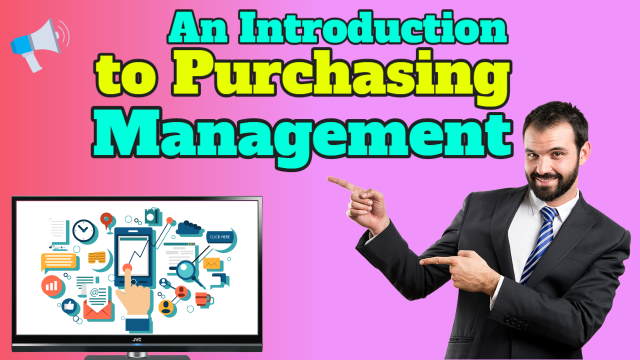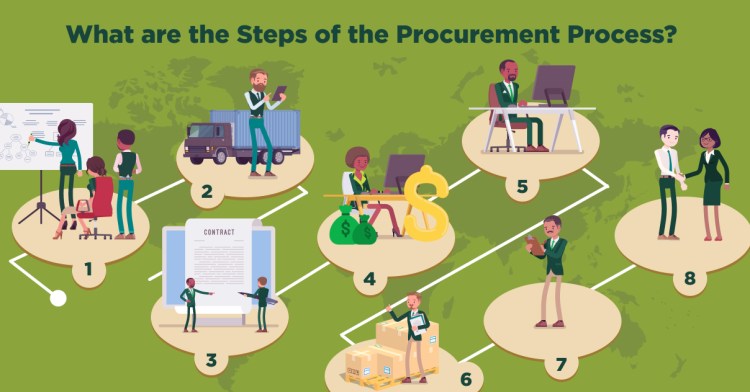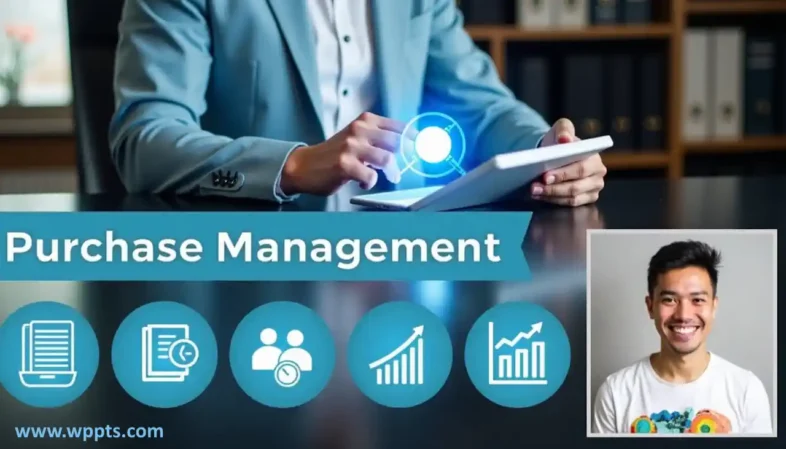The aim of Purchasing Management is to achieve optimum “procurement”. Procurement is the strategic process of acquiring goods and services a company needs to operate, which includes sourcing, purchasing, and managing suppliers. It goes beyond simple purchasing by encompassing the entire lifecycle from identifying needs and selecting vendors to negotiating contracts and managing the ongoing relationship with suppliers. The core goal is to obtain the best value, quality, and reliability for the organization, ensuring business continuity and profitability.
Key Takeaways
- Effective purchasing management can reduce operational costs by 5-15% while strengthening your supply chain resilience and vendor relationships
- The six core elements of procurement management create a systematic approach that eliminates maverick spending and improves budget accuracy
- Strategic sourcing goes beyond cost-cutting to build sustainable supplier relationships that can weather market disruptions
- Technology solutions like e-procurement systems and spend analytics tools can transform manual processes into strategic advantages
- Organizations that align procurement strategies with business objectives achieve 3x better results than those treating purchasing as a purely transactional function

Purchasing management is the backbone of business operations, yet many organizations still treat it as an afterthought rather than a strategic function. When implemented correctly, a robust procurement strategy doesn't just save money – it drives innovation, mitigates risk, and creates competitive advantage. Amazon Business provides solutions that streamline these processes, helping organizations transform their purchasing operations from tactical to strategic.
The difference between merely surviving and truly thriving often comes down to how effectively an organization manages its purchasing and procurement functions. With up to 70% of revenue typically spent on external purchases, even small improvements in procurement efficiency can dramatically impact your bottom line.
How the supply chain is managed and organized has become a functional and strategic aim. If the purchasing department gets it right and you will gain a vital competitive edge in an extremely tough, post-COVID competitive situation.
Hit the wrong note, however, and your business will be brought into a nosedive from which the business may not recover. What factors have brought supply chain management worries into the prominent position they now enjoy?
The Ideal Skills Will Succeed In Procurement
The realities of a world marketplace arranged around supply chains backed up by advanced data modeling, rely on the correct staff. Finding and keeping, on an international level, the people who are able to recognize and execute the supply chain reforms you want is perhaps the single most crucial factor upon which successful long term supply chain management rests.
Who do we need – and where are they? The people who will deliver the optimum results in their part of the chain? That is the problem for procurement professionals everywhere.
(First published Jun 4, 2013.)

“What is Procurement Management? – Key …” from www.michiganstateuniversityonline.com and used with no modifications.
The Hidden Costs of Poor Purchasing Management
Ineffective purchasing management silently drains resources through numerous hidden costs that rarely appear as line items on financial statements. When purchases occur without proper oversight, organizations typically pay 15-27% more than necessary for goods and services. This premium results from missing volume discounts, failing to consolidate vendors, and lost negotiation opportunities.
Beyond direct price premiums, poor purchasing practices create operational inefficiencies that ripple throughout the organization. Consider the administrative cost of processing invoices – studies show that manual processing costs between $10-$30 per invoice compared to $2-$3 with automated systems. For organizations processing thousands of invoices annually, this inefficiency alone can represent hundreds of thousands in wasted resources.
The most insidious cost, however, may be opportunity cost. When procurement teams spend 80% of their time on transactional activities rather than strategic initiatives, they miss chances to innovate, develop supplier relationships, and create competitive advantage. Organizations with mature procurement functions typically redirect these resources toward value-adding activities that drive growth.
“The average organization can reduce procurement costs by 8-12% simply by implementing basic purchasing controls and spend visibility tools. For a company spending $10M annually, that's $800,000-$1.2M in potential savings.”
6 Core Elements of Effective Procurement Management
- Clear procurement policies and procedures that establish governance
- Strategic supplier selection and evaluation frameworks
- Streamlined purchase requisition and approval workflows
- Centralized purchase order management
- Efficient receiving and invoice reconciliation processes
- Comprehensive spend analysis and performance metrics
These foundational elements create a procurement ecosystem that balances control with efficiency. When properly implemented, they transform procurement from a reactive function to a proactive strategic partner within the organization.

“Procurement – Wikipedia” from en.wikipedia.org and used with no modifications.
Clear Procurement Policies and Procedures
Well-defined policies serve as the foundation for all procurement activities, establishing governance structures and decision-making frameworks. These guidelines should clearly communicate who can purchase what, from whom, and under what circumstances. Effective policies balance necessary controls with practical flexibility, preventing both maverick spending and bureaucratic bottlenecks that frustrate stakeholders.
The most successful procurement policies align with organizational objectives while remaining practical enough for everyday application. They should address authorization levels, preferred supplier lists, competitive bidding thresholds, and ethical standards. Regular updates ensure these policies evolve with changing business needs and market conditions.
Strategic Supplier Selection and Evaluation
Selecting the right suppliers involves much more than comparing price quotes. Strategic supplier selection evaluates potential partners across multiple dimensions including quality, reliability, innovation capabilities, financial stability, and cultural alignment. This comprehensive approach identifies partners who can deliver value beyond mere cost savings.
Formal supplier evaluation frameworks provide objective criteria for comparing options and documenting selection decisions. These frameworks typically include weighted scoring systems that prioritize factors most relevant to specific categories of spend. Regular performance reviews ensure suppliers continue meeting expectations and identify opportunities for continuous improvement.
Forward-thinking organizations also consider diversity and sustainability in their supplier selection processes. Beyond meeting corporate social responsibility goals, diverse and sustainable supply chains often demonstrate greater resilience during disruptions and can uncover innovative solutions to business challenges.
Purchase Requisition and Approval Workflows
Efficient requisition processes balance control with convenience, ensuring purchases receive appropriate review without creating workflow bottlenecks. Digital requisition systems capture essential information upfront, including cost centers, budget availability, and business justification. This structured approach reduces errors, improves budget accuracy, and creates accountability.
Purchase Order Management
Effective purchase order management serves as the central control mechanism for organizational spending. When properly implemented, PO systems create legal documentation, improve budget tracking, and enable spend visibility across departments. They establish clear expectations with suppliers regarding pricing, delivery terms, and quality requirements, minimizing disputes later in the process.
Modern purchase order systems integrate with inventory management and accounting platforms to create seamless data flow throughout the organization. This integration eliminates duplicate data entry, reduces errors, and provides real-time visibility into outstanding commitments and budget impacts. For organizations managing hundreds or thousands of orders annually, these efficiency gains translate into significant resource savings.
Purchase order compliance represents a critical KPI for procurement teams. Low PO compliance (purchases made without proper documentation) indicates control gaps that expose the organization to pricing inconsistencies, budget overruns, and potential fraud. Leading organizations typically achieve 85-95% PO compliance through budget tips, user-friendly systems and organizational education initiatives.
Receiving and Invoice Reconciliation
The three-way matching process (purchase order, receiving documentation, and supplier invoice) provides essential financial controls that prevent overpayment and ensure contract compliance. This verification step confirms that goods were received as ordered and that pricing matches negotiated terms. Despite its importance, many organizations struggle with manual reconciliation processes that delay payments and strain supplier relationships.
Automated reconciliation tools dramatically improve efficiency by flagging exceptions rather than requiring manual review of every transaction. This approach focuses limited resources on resolving actual discrepancies while streamlining payment for properly matched transactions. The result is faster payment cycles, improved supplier satisfaction, and potential early payment discounts. To learn more about effective procurement strategies, visit this guide on the purchasing process.
Spend Analysis and Performance Metrics
Data-driven procurement depends on comprehensive spend analysis to identify patterns, opportunities, and anomalies across the organization's purchasing activity. This analysis provides visibility into category-level spending, supplier concentration, pricing trends, and compliance metrics. Without this intelligence, procurement decisions rely on assumptions rather than evidence.
Beyond traditional spend analysis, leading procurement organizations develop performance dashboards that track KPIs across efficiency, effectiveness, and innovation dimensions. These metrics might include cost savings, cycle times, supplier diversity, and sustainability impacts. Regular review of these metrics drives continuous improvement and helps demonstrate procurement's strategic value to executive leadership.
Building Your Procurement Strategy from the Ground Up
A cohesive procurement strategy aligns purchasing activities with organizational objectives while maximizing value beyond simple cost reduction. This strategic approach requires shifting procurement's role from transactional processor to business partner. The most effective strategies balance competing priorities including cost, quality, innovation, and risk management to optimize overall value.

Align Procurement with Business Objectives
Procurement strategies must directly support core business goals to deliver maximum value. This alignment begins with understanding organizational priorities – whether growth, profitability, innovation, or risk mitigation. For manufacturing companies, procurement might focus on supply continuity and quality assurance. For service organizations, the emphasis might shift toward cost control and vendor management.
Regular collaboration between procurement and business units ensures continued alignment as priorities evolve. This partnership approach helps procurement teams anticipate needs rather than simply reacting to requests. It also creates opportunities to demonstrate procurement's strategic value beyond processing transactions and negotiating discounts.
Conduct Spend Analysis to Identify Opportunities
Comprehensive spend analysis provides the foundation for strategic procurement decisions by revealing patterns and opportunities across the organization's purchasing activity. This analysis typically classifies expenditures by category, supplier, department, and time period to identify consolidation opportunities, pricing inconsistencies, and compliance issues. The resulting insights guide prioritization of procurement initiatives for maximum impact.
Modern spend analysis goes beyond simple categorization to uncover actionable insights. Advanced techniques might include price variance analysis across business units, identification of maverick spending patterns, or evaluation of supplier concentration risks. These deeper analyses require clean data and sophisticated analytical tools but deliver significantly greater value than basic reporting.
Segment Your Supplier Base
Strategic supplier segmentation recognizes that not all vendors require the same management approach. By categorizing suppliers based on business impact and complexity, procurement teams can allocate resources more effectively. Strategic partners delivering critical components might warrant close collaboration and relationship investment, while commodity providers need streamlined processing and competitive pressure.
Effective segmentation typically considers both current value and future potential. Some suppliers may offer modest spend today but represent strategic opportunities through innovation capabilities, sustainability practices, or market insights. This forward-looking perspective prevents over-focusing on legacy suppliers at the expense of developing new relationships with transformative potential.
Develop Category Management Approaches
Category management provides a structured methodology for optimizing specific spend areas based on market characteristics and internal requirements. This approach treats related purchases as strategic portfolio elements rather than isolated transactions. Category strategies typically define sourcing approaches, supplier relationships, and performance metrics specific to each spend area.
Successful category management requires deep market knowledge and cross-functional collaboration. Category teams often include stakeholders from operations, finance, and user departments alongside procurement specialists. This diverse expertise ensures strategies balance technical requirements, financial considerations, and practical implementation challenges.
Strategic Sourcing: Finding the Right Suppliers
Strategic sourcing elevates purchasing from a transaction-focused activity to a value-creation process. Unlike conventional buying, which often prioritizes immediate price considerations, strategic sourcing takes a comprehensive view that includes quality, innovation capacity, risk factors, and total cost of ownership. This approach typically delivers 5-15% cost savings while improving performance across multiple dimensions.
The 7-Step Strategic Sourcing Process
Effective strategic sourcing follows a structured methodology that ensures consistent results across different categories and teams. The process begins with internal assessment and spend analysis to identify opportunities and requirements. This foundational step establishes baseline data for measuring improvements and helps prioritize categories based on potential impact.
Market analysis forms the next critical phase, where procurement teams research supplier capabilities, industry trends, and competitive dynamics. This external perspective helps identify innovative approaches and sets realistic expectations for what's achievable. The most successful teams complement published market data with direct supplier engagement to uncover emerging capabilities and relationship opportunities.
Supplier selection represents the culmination of previous steps, applying structured evaluation criteria to identify partners who offer the best overall value proposition. This selection extends beyond initial pricing to consider total cost of ownership, innovation capabilities, risk factors, and strategic alignment. The final steps involve implementation planning, contract negotiation, and performance measurement to ensure expected benefits materialize.
RFP vs. RFQ vs. RFI: Choosing the Right Tool
Selecting the appropriate solicitation method significantly impacts sourcing outcomes. Request for Information (RFI) processes work best for gathering market intelligence and supplier capabilities when requirements remain fluid. This approach helps narrow the supplier field while gaining insights that might influence final specifications. For instance, understanding supplier capabilities in specific industries can be crucial for making informed decisions.
Request for Quotation (RFQ) processes suit well-defined commodity purchases where specifications are fixed and price represents the primary decision factor. By contrast, Request for Proposal (RFP) methodologies better serve complex purchases requiring supplier innovation and flexibility. The most sophisticated procurement teams customize their approach based on category characteristics rather than applying one-size-fits-all templates.
Negotiation Tactics That Save Money
Effective negotiation strategies extend far beyond simplistic price haggling to create sustainable value for both parties. Preparation represents the most crucial element, including detailed cost analysis, alternative supplier identification, and clear understanding of both parties' interests. This homework provides leverage without resorting to confrontational tactics that damage relationships.
Multi-variable negotiation approaches recognize that price represents just one element of supplier agreements. By incorporating payment terms, delivery schedules, service levels, and innovation commitments, skilled negotiators create packages that deliver greater overall value than narrow price focus. These approaches often yield better results while preserving relationship capital for future collaboration.

Building Win-Win Supplier Relationships
Transactional purchasing mindsets limit potential value by treating suppliers as interchangeable vendors rather than strategic partners. Collaborative relationships unlock additional benefits including preferential capacity allocation, early access to innovations, and joint process improvements. These partnerships require investment from both sides but typically deliver superior long-term results.
Supplier relationship management programs formalize collaboration through regular performance reviews, executive sponsorship, and shared improvement initiatives. The most effective programs balance accountability with genuine partnership, addressing performance issues directly while recognizing mutual dependency. This balanced approach avoids both complacency and adversarial dynamics that undermine value creation.
Technology Solutions That Transform Procurement
Digital transformation has revolutionized procurement capabilities, enabling automation of routine tasks while providing unprecedented visibility into organizational spending. These technologies shift procurement's focus from transaction processing to strategic activities that deliver greater value. Organizations leveraging procurement technology typically achieve 25-50% greater efficiency alongside improved compliance and decision quality.
E-Procurement Systems
E-procurement platforms digitize the purchasing process from requisition through payment, creating streamlined workflows and accountability. These systems typically include catalog management, approval routing, purchase order generation, and receiving functionality. By centralizing these processes, organizations gain control over spending while simplifying the purchasing experience for end users.
Modern e-procurement solutions incorporate mobile capabilities, allowing approvals and status updates from anywhere. This accessibility prevents process bottlenecks while maintaining appropriate controls. Integration capabilities with ERP systems, supplier networks, and payment platforms further enhance efficiency by eliminating manual data transfers and reconciliation.
Spend Analytics Tools
Spend analytics solutions transform raw transaction data into actionable insights that drive strategic decisions. These tools aggregate data across systems, apply consistent categorization, and provide visualization capabilities that reveal patterns and opportunities. Advanced platforms incorporate AI capabilities to identify savings opportunities, compliance issues, and supplier concentration risks automatically.
The most valuable analytics tools provide both high-level dashboards for executives and detailed drill-down capabilities for category managers. This multilevel visibility helps organizations identify strategic opportunities while addressing tactical issues. Regular refresh cycles ensure decision-makers work with current information rather than historical snapshots.
Contract Management Software
Contract lifecycle management platforms centralize agreement documentation while automating renewal alerts and compliance monitoring. These systems create digital repositories that enhance visibility into commitments, obligations, and expiration dates. By proactively managing contract milestones, organizations avoid costly auto-renewals and capture negotiated benefits that might otherwise go unrealized.
Advanced contract management tools incorporate clause libraries and templating capabilities that accelerate agreement creation while ensuring compliance with organizational standards. Integration with e-signature solutions further streamlines the process, reducing cycle times from weeks to days or hours. This efficiency becomes particularly valuable when managing hundreds or thousands of agreements across the organization.
Supplier Relationship Management Platforms
SRM systems formalize supplier interactions through structured onboarding, performance monitoring, and collaboration tools. These platforms centralize supplier information including certifications, performance metrics, risk assessments, and development plans. This consolidated view helps organizations manage supplier portfolios strategically rather than handling each relationship in isolation.
The most effective SRM implementations balance technology with human relationship management. While platforms provide structure and data management, successful supplier relationships still require interpersonal skills and executive engagement. Organizations achieving the greatest value typically combine digital tools with formal governance structures and relationship managers.
Automation and AI in Procurement
Artificial intelligence and robotic process automation increasingly handle routine procurement tasks, freeing human resources for higher-value activities. AI applications analyze spending patterns to identify optimization opportunities, predict supplier performance issues, and detect potential compliance violations before they occur. These capabilities transform procurement from reactive to proactive, anticipating needs rather than simply responding to them. For example, incorporating AI can be as innovative as rain-proofing your treehouse design with essential tips to enhance efficiency.
Process automation addresses labor-intensive tasks like invoice matching, catalog updates, and routine reordering. These applications follow business rules to handle standard transactions while flagging exceptions for human review. By eliminating manual processing for routine activities, organizations dramatically improve efficiency while reducing error rates.
Measuring Procurement Success: KPIs That Matter
Effective performance measurement provides visibility into procurement's contribution while identifying improvement opportunities. A balanced scorecard approach typically includes metrics across cost, quality, efficiency, innovation, and risk dimensions. This multifaceted view prevents overemphasis on cost reduction at the expense of other value drivers.
Cost Savings and Avoidance
Cost measurement methodologies should distinguish between different types of value creation including hard savings (price reductions), cost avoidance (preventing increases), and process efficiencies. Clear definitions and calculation methodologies ensure consistent tracking across categories and time periods. The most sophisticated organizations validate savings with finance teams to ensure procurement metrics align with financial results.
Beyond direct purchase costs, comprehensive metrics consider total cost of ownership including quality impacts, inventory carrying costs, and administrative expenses. This holistic view prevents false economies where apparent savings in purchase price create larger costs elsewhere in the organization. It also helps procurement teams prioritize initiatives with greatest overall impact. For example, incorporating sustainable styling can be a strategic move to manage long-term costs effectively.
Procurement Cycle Time
Time efficiency metrics track procurement's responsiveness from requisition to fulfillment. These measures highlight process bottlenecks while demonstrating procurement's impact on operational agility. Breaking the cycle into component parts (requisition approval, supplier selection, order placement, delivery) helps identify specific improvement opportunities, such as incorporating sustainable practices into procurement processes.
Leading organizations establish differentiated service levels based on business criticality rather than applying uniform standards. Routine purchases might follow standardized processes optimized for efficiency, while urgent operational needs receive expedited handling. This segmented approach balances control with business responsiveness.
Supplier Performance Metrics
Comprehensive supplier evaluation frameworks measure performance across multiple dimensions including quality, delivery reliability, responsiveness, and innovation. These structured assessments provide objective data for supplier development conversations and future sourcing decisions. Regular review cadences ensure issues receive timely attention before impacting operations.
Advanced programs incorporate both quantitative metrics and qualitative assessments from stakeholders across the organization. This balanced approach captures technical performance alongside relationship factors that influence long-term success. The most sophisticated programs include two-way evaluations where suppliers also assess the organization's performance as a customer.
Compliance Rate
Compliance metrics track adherence to procurement policies, providing visibility into maverick spending and process exceptions. These measures typically include percentage of spend covered by contracts, purchase order compliance rates, and competitive bidding compliance. Regular reporting identifies departments or categories requiring additional training or process modifications.
Effective compliance programs balance control with practicality, recognizing that excessive rigidity can drive workarounds rather than adherence. The goal should be appropriate governance rather than bureaucracy for its own sake. Leading organizations establish risk-based controls that apply greater scrutiny to high-value or high-risk purchases while streamlining processes for routine items.
Common Procurement Pitfalls and How to Avoid Them
Even well-designed procurement programs encounter challenges that can undermine effectiveness. Recognizing these common pitfalls helps organizations implement preventive measures rather than struggling with remediation. The most successful transformation initiatives anticipate resistance points and address them proactively through change management and stakeholder engagement.
Maverick Spending
Unauthorized purchases outside established processes undermine negotiated agreements while creating compliance and budget risks. This behavior typically stems from perceived procurement complexity, urgency needs, or lack of awareness rather than deliberate policy violation. Effective prevention strategies address root causes through streamlined processes, user education, and appropriate consequences for non-compliance.
Technology solutions can significantly reduce maverick spending by making compliant purchasing easier than alternatives. User-friendly interfaces, mobile accessibility, and guided buying capabilities remove friction from the approved process. Integration with payment systems further enhances control by preventing reimbursement for unauthorized purchases.
Poor Supplier Management
Inadequate supplier oversight creates risks ranging from service disruptions to compliance violations and missed improvement opportunities. This deficiency often results from focusing exclusively on transactional activities rather than relationship management and performance development. Structured supplier management programs with clear responsibilities and review cadences help prevent these issues.
Inadequate Contract Management
Contract value leakage occurs when organizations fail to capture negotiated benefits through inconsistent implementation or inadequate monitoring. Common issues include missed renewal opportunities, overlooked volume discounts, and unauthorized price increases. Centralized contract repositories with automated alerting and compliance monitoring help prevent these losses.
Beyond administrative management, effective contract utilization requires making agreements accessible to relevant stakeholders and embedding terms in operational systems. Integration between contract management platforms and purchasing systems ensures negotiated pricing appears in catalogs and purchase orders. Regular compliance reviews identify deviations before they become established patterns.
Resistance to Change
Procurement transformations frequently encounter resistance from stakeholders comfortable with existing processes or concerned about losing autonomy. This resistance manifests through workarounds, delayed adoption, or outright opposition to new initiatives. Successful change management addresses these challenges through stakeholder engagement, clear communication of benefits, and executive sponsorship.
The Future of Procurement: Trends to Watch
The procurement function continues evolving from transactional purchasing toward strategic business partnership. Emerging technologies including predictive analytics, blockchain for supply chain transparency, and cognitive procurement assistants promise further transformation. Organizations that anticipate these trends can gain competitive advantage through earlier adoption and capability development.
Sustainability considerations increasingly influence procurement decisions as organizations address environmental impact, social responsibility, and governance requirements. Leading procurement teams incorporate these factors into supplier selection criteria and performance metrics rather than treating them as separate initiatives. This integrated approach recognizes that sustainable practices often align with long-term business value through risk reduction, innovation, and brand enhancement.
Your Procurement Transformation Roadmap
Successful procurement transformation requires a structured approach that balances short-term wins with long-term capability building. The journey typically begins with spending analysis and opportunity assessment to identify priority areas and establish baseline metrics. This fact-based foundation helps secure executive support while focusing initial efforts where they'll deliver greatest impact.
Policy development and process design create the structural framework for improved procurement performance. These foundational elements should balance control requirements with operational flexibility to avoid creating bureaucracy that stakeholders will resist. Technology selection follows process design rather than driving it, ensuring systems support business requirements rather than forcing adaptation to software limitations.
Implementation planning should include phased rollout strategies that deliver incremental value while managing change impact. Pilot programs with receptive departments help refine approaches before broader deployment. Clear communication of benefits, training programs, and visible executive support significantly improve adoption rates during implementation.
Continuous improvement mechanisms ensure the transformation delivers sustainable benefits rather than temporary gains. Regular performance reviews, stakeholder feedback sessions, and benchmarking against industry standards help identify new opportunities and address emerging challenges. This ongoing evolution prevents regression to previous practices while adapting to changing business needs.
- Conduct comprehensive spend analysis to identify opportunities
- Develop procurement policies aligned with business objectives
- Design efficient processes balancing control with usability
- Select appropriate technology enablers based on requirements
- Implement through phased approach with change management
- Measure results and establish continuous improvement cycle
Frequently Asked Questions
Organizations embarking on procurement transformation typically encounter similar questions about approach, resource requirements, and expected outcomes. These common inquiries reflect shared challenges across industries and organization sizes. While specific answers should adapt to individual circumstances, certain foundational principles apply broadly.
The following responses address frequently asked questions based on implementation experience across diverse organizations. These insights can help guide decision-making and set realistic expectations for procurement transformation initiatives.
What's the difference between purchasing and procurement?
Purchasing represents the transactional component of acquiring goods and services, focusing on the actual buying process from requisition through payment. Procurement encompasses a broader strategic function that includes purchasing transactions alongside supplier relationship management, category strategy development, and value optimization. Think of purchasing as a subset of procurement – procurement develops the strategy and framework, while purchasing executes the transactional elements within that framework.
How do I calculate procurement ROI?
Comprehensive procurement ROI calculations consider both direct financial benefits and operational improvements. The financial component typically includes hard savings (negotiated price reductions), cost avoidance (preventing increases), process efficiencies (reduced administrative costs), and working capital improvements (payment term optimization). These benefits should be compared against implementation costs including technology investments, consulting services, and internal resource allocation.
Beyond pure financial metrics, many organizations incorporate broader business impacts into ROI calculations. These might include risk reduction, sustainability improvements, innovation contributions, and supplier diversity achievements. While less directly quantifiable, these factors often drive significant value over time.
| Investment Category | Typical Costs | Expected Return | Timeframe |
|---|---|---|---|
| Technology Implementation | $50K-$500K+ | 3x-5x investment | 12-24 months |
| Process Redesign | $25K-$150K | 5x-10x investment | 6-12 months |
| Strategic Sourcing | 5-15% of category value | 3x-7x investment | 3-6 months |
Most organizations achieve full ROI on procurement transformation investments within 12-18 months, with ongoing returns continuing well beyond the initial payback period. Early wins in high-value categories often fund subsequent implementation phases, creating self-sustaining momentum for the transformation journey.
Should small businesses invest in procurement software?
Even smaller organizations can benefit from procurement technology, though their requirements typically differ from enterprise needs. Cloud-based solutions with subscription pricing models have made sophisticated capabilities accessible without large capital investments. Small businesses should prioritize core functionality addressing their specific pain points rather than implementing comprehensive suites with features they won't utilize.
For organizations processing fewer than 1,000 purchase orders annually, basic e-procurement solutions focusing on requisition workflow, purchase order generation, and simple approval routing often deliver sufficient value. As volume increases or requirements grow more complex, additional capabilities like supplier management, contract repositories, and spend analytics become increasingly valuable. The key is selecting right-sized solutions that deliver meaningful benefits without excessive complexity.
How can I reduce maverick spend in my organization?
Effective maverick spend reduction combines process improvements, technology enablement, and organizational change management. The process component should focus on simplifying compliant purchasing while addressing legitimate business needs driving workarounds. Technology should make approved purchasing paths more convenient than alternatives through user-friendly interfaces, guided buying, and mobile accessibility.
The organizational dimension requires both carrot and stick approaches – demonstrating benefits of compliance while establishing consequences for violations. Clear communication about why procurement policies exist (beyond cost control) helps build understanding and support. Executive sponsorship proves particularly important, as leadership behavior significantly influences adoption throughout the organization.
What qualifications should I look for when hiring procurement professionals?
Modern procurement requires diverse skills extending beyond traditional negotiation and purchasing capabilities. Technical qualifications should include category expertise, financial analysis abilities, and technology proficiency appropriate to your systems environment. Professional certifications like CPSM (Certified Professional in Supply Management) or CPM (Certified Purchasing Manager) demonstrate commitment to the profession and foundational knowledge.
Beyond technical capabilities, successful procurement professionals need strong business acumen, relationship management skills, and communication abilities. These soft skills enable effective stakeholder collaboration and supplier partnerships essential for strategic procurement. The best candidates combine analytical rigor with interpersonal effectiveness and business orientation.
Treehouses have always been a symbol of adventure and creativity, but building one requires careful planning and design. One important aspect to consider is the support structure, which often involves choosing the right type of tree. For instance, an oak tree is a popular choice due to its strength and durability. Ensuring that the tree can handle the weight and stress of a treehouse is crucial to creating a safe and lasting structure.
[Published 2013. Updated Jun 22, 2020 and November 2025.]







Great blog.Thanks Again. Will read on…
I cannot thank you enough for the article post. Really Cool.
Really informative article. Much obliged.
“Great, thanks for sharing this blog post. Much thanks again. Fantastic.”
Enjoyed every bit of your post. Much thanks again. Fantastic.
Awesome blog post. Keep writing.